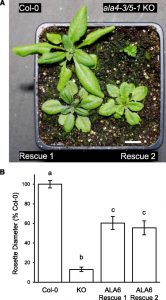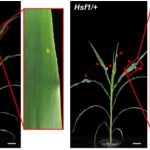Certain Flippases Are Important for Vegetative Growth
Lipid flippases hydrolyze ATP to flip lipids across a membrane bilayer toward cytosolic facing leaflets, whether that be from the outer leaflet of the plasma membrane (PM) or luminal leaflet of internal membranes. Flippases are proposed to be involved in multiple processes, such as  flipping specific lipids to generate an asymmetric distribution between the leaflets of a membrane bilayer, generating membrane curvature, assisting vesicle formation, importing lipids from the environment, and facilitating lipid metabolism. In plants, aminophospholipid ATPases (ALAs) are lipid flippases involved in transporting specific lipids across membrane bilayers. Arabidopsis contains 12 ALAs in five phylogenetic clusters, including four in cluster 3 (ALA4–ALA7). ALA4/5 and ALA6/7, are expressed primarily in vegetative tissues and pollen, respectively. Previously, a double knockout of ALA6/7 was shown to result in pollen fertility defects. Here, Davis et al. (10.1104/pp.19.01332) show that a double knockout of ALA4/5 results in dwarfism, characterized by reduced growth in rosettes, roots, bolts, and hypocotyls. Reduced cell size was observed for multiple vegetative cell types, suggesting a role for ALA4/5 in cellular expansion. Members of the third ALA cluster are at least partially interchangeable, as transgenes expressing ALA6 in vegetative tissues partially rescued ala4/5 mutant phenotypes, and expression of ALA4 transgenes in pollen fully rescued ala6/7 mutant fertility defects. Lipid profiling revealed ala4/5 rosettes had perturbations in glycerolipid and sphingolipid content. Assays using yeast revealed that ALA5 can flip a variety of glycerolipids and the sphingolipid sphingomyelin across membranes. Together, these results support a model whereby ALA4 and ALA5 function as lipid flippases that contribute to lipid homeostasis, cellular expansion, and plant growth.
flipping specific lipids to generate an asymmetric distribution between the leaflets of a membrane bilayer, generating membrane curvature, assisting vesicle formation, importing lipids from the environment, and facilitating lipid metabolism. In plants, aminophospholipid ATPases (ALAs) are lipid flippases involved in transporting specific lipids across membrane bilayers. Arabidopsis contains 12 ALAs in five phylogenetic clusters, including four in cluster 3 (ALA4–ALA7). ALA4/5 and ALA6/7, are expressed primarily in vegetative tissues and pollen, respectively. Previously, a double knockout of ALA6/7 was shown to result in pollen fertility defects. Here, Davis et al. (10.1104/pp.19.01332) show that a double knockout of ALA4/5 results in dwarfism, characterized by reduced growth in rosettes, roots, bolts, and hypocotyls. Reduced cell size was observed for multiple vegetative cell types, suggesting a role for ALA4/5 in cellular expansion. Members of the third ALA cluster are at least partially interchangeable, as transgenes expressing ALA6 in vegetative tissues partially rescued ala4/5 mutant phenotypes, and expression of ALA4 transgenes in pollen fully rescued ala6/7 mutant fertility defects. Lipid profiling revealed ala4/5 rosettes had perturbations in glycerolipid and sphingolipid content. Assays using yeast revealed that ALA5 can flip a variety of glycerolipids and the sphingolipid sphingomyelin across membranes. Together, these results support a model whereby ALA4 and ALA5 function as lipid flippases that contribute to lipid homeostasis, cellular expansion, and plant growth.



